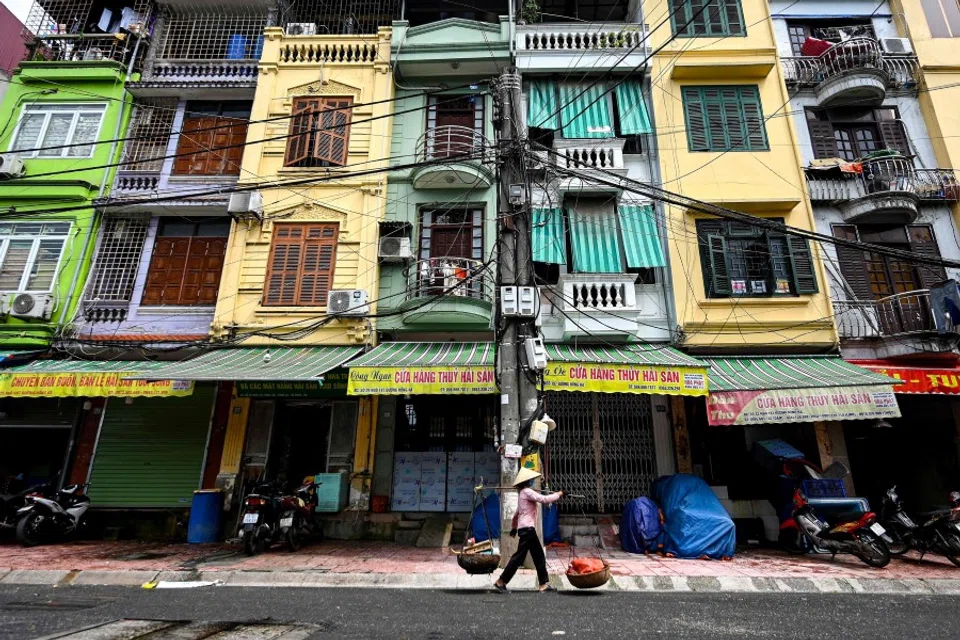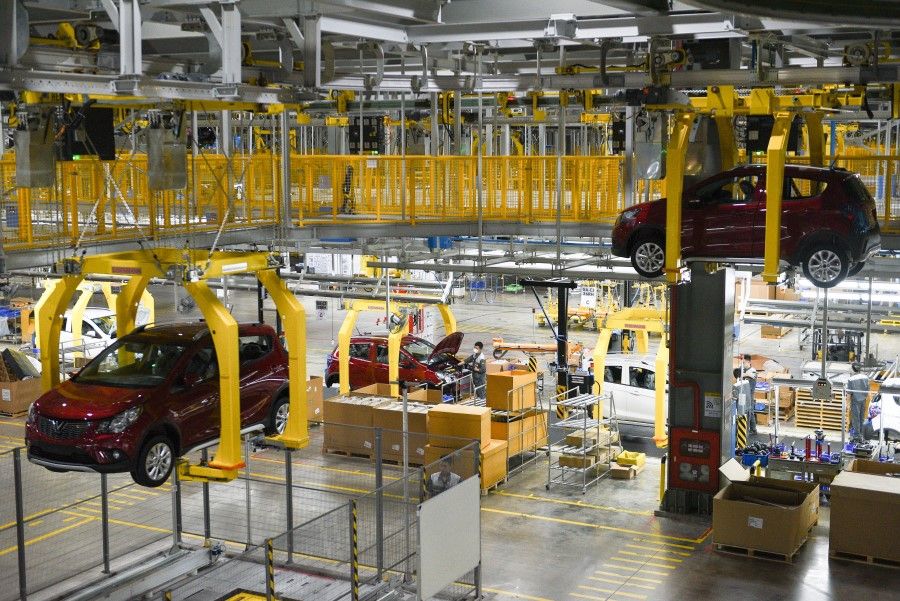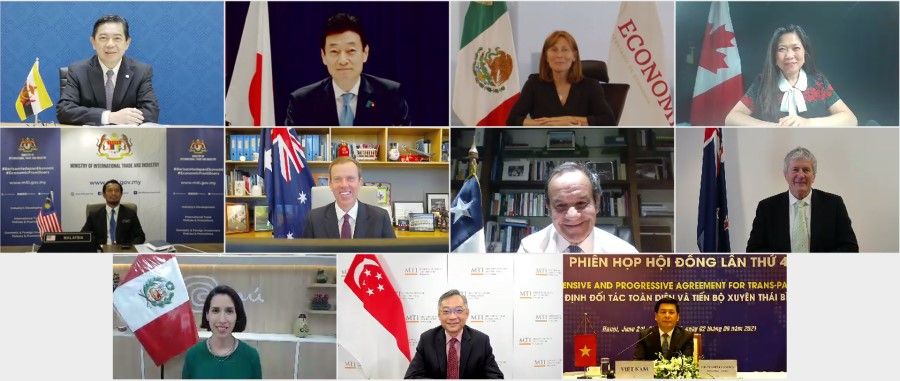Vietnam needs to do more to reduce trade dependence on China

China and Vietnam share a long border of 1,306 km, which has facilitated bilateral trade since the normalisation of bilateral relations in 1991. The two-way trade has grown dramatically, and China has been Vietnam's largest trading partner since 2004. The structure of bilateral trade, however, reveals Vietnam's substantial dependence on China.
Due to the intensifying disputes between the two countries in the South China Sea, this has been increasingly seen by policymakers in Hanoi as a security vulnerability for Vietnam. Hanoi has therefore made conscious efforts to reduce its trade dependence on Beijing. In particular, since 2014, it has signed a string of Free Trade Agreements (FTAs) with different countries to diversify its economic relations and mitigate its economic vulnerability vis-à-vis China.
Importing too much and too easily from China has constrained Vietnam's economic potentials and failed to motivate Vietnamese businesses to strengthen their manufacturing capabilities.
Vietnam-China trade ties before 2014
Vietnam has run a chronic trade deficit with China since the latter joined the World Trade Organization. From US$211 million in 2001, the deficit grew to US$10.01 billion in 2008, when the two countries signed a comprehensive strategic partnership of cooperation.
In the joint statement announcing the partnership, "the two sides agreed to actively explore new growth points in the bilateral trade, maintain fast growth of two-way trade and at the same time adopt effective measures to improve trade mix to achieve balanced development in a spirit of complementarity, mutual benefit and win-win results."
However, that objective has not been achieved as Vietnam's trade deficit with China continues to widen, reaching US$18.52 billion in 2014. Importing too much and too easily from China has constrained Vietnam's economic potentials and failed to motivate Vietnamese businesses to strengthen their manufacturing capabilities.
Vietnam has also relied heavily on China for intermediate goods (inputs used to produce final goods or finished products). In 2000, Vietnam imported US$1.40 billion worth of intermediate goods from China, accounting for 31.47% of all imports from the latter that year. By 2014, that number had soared to US$16.97 billion, accounting for 38.88% of Vietnam's total imports from China.
Many of Vietnam's key export industries, such as textiles, garments and footwear, still heavily depend on inputs imported from China. In 2010, for example, Vietnam imported US$3.13 billion raw materials and accessories for its textile, leather and shoe industries from China, which accounted for 31.94% of total imports for this product category. By 2014, the main fabric supplier for Vietnam remained China, with a turnover of US$4.66 billion, accounting for 49.47% of all the fabrics that Vietnam imported that year.
Vietnam also depends on China for capital goods, which includes machinery, equipment, vehicles, and tools used to make finished goods. In 2000, Vietnam imported US$600 million of capital goods from China, accounting for 42.85% of all imports from the latter. By 2014, that figure had climbed to US$20.19 billion, 33 times higher than in 2000 and accounting for 46.25% of Vietnam's total imports from China.
Heavy dependence on imported intermediate and capital goods from China heightens the vulnerability of Vietnam's entire production chain. If supplies from China were disrupted, Vietnam would face serious economic consequences.

Likewise, Vietnamese businesses that export mostly to China are also vulnerable. For example, China was the leading export market for Vietnam's rubber in 2010, taking in 464,000 tons and thus accounting for 59.4% of Vietnam's total rubber exports. In 2014, China was still the largest export market for Vietnamese rubber. In addition, Vietnam's fruit and vegetable products were mainly exported to China to a value of US$436 million in the same year, accounting for 29.2% of the country's total export in this category.
China's weaponisation of trade and Vietnam's policy changes
China has a record of using trade as a weapon to punish countries with which it quarrels.
In 2010, for instance, Beijing barred shipments of rare earth minerals to Japan following the latter's detention of a Chinese fishing captain near the disputed Senkaku/Diaoyu islands. Later that year, China reacted with fury when the Oslo-based Nobel Peace Prize committee revealed that it would honour Chinese dissident Liu Xiaobo. This resulted in the collapse of Norwegian exports of fresh and frozen salmon to China. During the Scarborough Shoals standoff in 2012, China imposed import restrictions on bananas from the Philippines. After South Korea allowed the US to deploy a Terminal High Altitude Area Defense (THAAD) system in 2017, China carried out an aggressive campaign of economic retaliation, including allowing fewer tourists to travel to South Korea, and limiting domestic distribution of South Korean entertainment products, cosmetics as well as automobiles. Following Australian Prime Minister Scott Morrison's call for an international inquiry into the origins of the Covid-19 pandemic in 2020, China abruptly imposed a ban on lobster imports from Australia, affecting 96% of Australian exports of southern rock lobsters. Since then, China has also imposed restrictions on imports of Australian coal, meat, cotton, wool, barley, wheat, timber, copper, sugar and wine.
Vietnam has been trade-dependent on China for a long time, but only after a major bilateral crisis in the South China Sea broke out in 2014 did Vietnam feel the urgency to diversify its economic relations away from China to mitigate risks.
In May 2014, Beijing deployed a giant oil rig in Vietnam's exclusive economic zone (EEZ) off its central coast, triggering a wave of anti-China protests and riots in Vietnam that spiralled out of the government's control. Angry rioters in some central and southern provinces vandalised hundreds of factories thought to belong to Chinese companies, leaving at least six Chinese dead. Beijing issued travel warnings and evacuated many of its nationals. The number of Chinese tourists to Vietnam fell by half in the months that followed. The crisis sparked unprecedented public discourses about the extent and consequences of Vietnam's economic vulnerabilities vis-à-vis China.
In December 2014, Vietnamese Prime Minister Nguyen Tan Dung issued Decision No. 2146 to approve a "Blueprint on Restructuring the Industry and Trade Sectors to Serve the Cause of National Industrialisation, Modernisation and Sustainable Development through 2020, with a Vision toward 2030".
The document urged Vietnam to continue to increase exports rapidly by developing overseas markets, build and strengthen strategic partnerships for sustainable market development, and diversify import and export markets. Most importantly, the document called for "avoiding dependence on one single import market", the first time a Vietnamese official document has done so. It also directs the country to reasonably control imports and improve Vietnam's trade balance with main import markets. Although the document did not name China specifically, the drafters of the document clearly had China in mind.
As of August 2021, Vietnam has officially joined 15 FTAs, including six ASEAN FTAs with regional partners (China, South Korea, Japan, India, Australia, and New Zealand) and the Regional Comprehensive Economic Partnership.

The political report of the 11th Central Committee of the Communist Party of Vietnam presented at the 12th National Party Congress in 2016 also guided Vietnam to "continue to research, negotiate, sign, and carefully prepare conditions for the implementation of new-generation free trade agreements", actively integrate into the international economy, diversify international economic relations, and "avoid dependence on any particular market or partner". These points were repeated in the party's political report presented at its 13th National Congress in early 2021, with a view to "improving the economy's resilience to negative impacts from external fluctuations".
New-generation free trade agreements and their impact
Since 2014, Vietnam has made efforts to conclude many FTAs. As of August 2021, Vietnam has officially joined 15 FTAs, including six ASEAN FTAs with regional partners (China, South Korea, Japan, India, Australia, and New Zealand) and the Regional Comprehensive Economic Partnership. The Vietnam-UK FTA, which entered into force on 1 January 2021, is Vietnam's latest trade agreement.
Most notably, Vietnam is a party to two new-generation FTAs - the Comprehensive and Progressive Agreement for Trans-Pacific Partnership (CPTPP), which excludes China, and the European Union-Vietnam Free Trade Agreement (EVFTA). Unlike traditional FTAs that focus on tariff elimination, new-generation FTAs extend their scope to cover new areas, including state-owned enterprises, intellectual property, labour, environment, transparency, and sustainable development.
The CPTPP, which was formerly known as the Trans-Pacific Partnership (TPP), came into force on 14 January 2019. It has eleven parties, namely Australia, Brunei, Canada, Chile, Japan, Malaysia, Mexico, New Zealand, Peru, Singapore, and Vietnam. The EVFTA, which went into effect on 1 August 2020, is a trade agreement between Vietnam and 27 EU members.
Joining the two FTAs provides Vietnam better access to 37 markets in Asia, Europe, and Latin America, including those with which Vietnam does not have a bilateral trade agreement. Moreover, the CPTPP and EVFTA will provide stable and long-term frameworks for economic cooperation between Vietnam and important partners such as Japan, Australia, Canada, Singapore, and EU members, to reduce its trade dependence on China and to improve its strategic position vis-à-vis China, especially in the South China Sea.
As observed by the former American ambassador to Vietnam, Ted Osius: "Tension in the South China Sea and the TPP were related. Vietnam viewed the TPP as a strategic agreement that would prevent China from dominating its economy and enable it to secure diplomatic support when the Chinese resorted to bullying tactics."
Implementing these new-generation FTAs will bring Vietnam great opportunities for economic growth. The CPTPP is expected to increase Vietnam's exports by 4% and the country's gross domestic product (GDP) by 1.3%, by 2030. Meanwhile, the EVFTA is expected to increase Vietnam's exports to the EU by 20% by 2020, 42.7% by 2025, and 44.37% by 2030. The increase in imports from the EU is projected at 15.28% by 2020, 33.06% by 2025, and 36.7% by 2030. The EVFTA is also expected to raise Vietnam's GDP by 2.18 to 3.25% between 2019 and 2023, 4.57 to 5.30% between 2024 and 2028, and 7.07 to 7.72% between 2029 and 2033.

New-generation FTAs like the CPTPP and EVFTA will also stimulate Vietnam's institutional reforms, including refining the legal system and improving the investment and business environment. On 14 June 2019, for example, the National Assembly passed revised laws on insurance business and intellectual property. On 20 November 2019, it also passed a new Labour Code, which took effect in January 2021. The new code offers greater protection for employees and marks the first time Vietnam has allowed the establishment of independent trade unions. These moves are part of Vietnam's efforts to comply with international standards set in the new-generation FTAs that it has signed.
After one year of CPTPP implementation, Vietnam's trade deficit with China in 2019 continued to widen and reached a record high of US$32 billion, a 36% year-on-year increase.
Participating in the CPTPP and EVFTA also supports Vietnam's economic restructuring. For example, the two FTAs require products made in Vietnam to use a certain percentage of inputs originating from member states to enjoy preferential treatments offered in these agreements. This will encourage Vietnamese enterprises to use inputs from domestic sources, which, in turn, will stimulate the country's supporting industries. Before domestic suppliers can meet the demand, Vietnamese firms will need to import inputs from CPTPP and EU partners, thereby helping Vietnam reduce imports from China.
In addition, modern technologies from CPTPP members and EU countries will enter Vietnam. Although they may be more expensive than Chinese counterparts, they will over time produce high-quality and international-standard products that can be exported worldwide. Vietnam will therefore have a better chance to move up the global value chains.
However, Vietnam's endeavours to mitigate its trade dependence on China through these FTAs have not produced expected outcomes yet. After one year of CPTPP implementation, Vietnam's trade deficit with China in 2019 continued to widen and reached a record high of US$32 billion, a 36% year-on-year increase. That year, Vietnam imported US$35.73 billion of capital goods and US$26.60 billion of intermediate goods from China, which accounted for 47.26% and 35.20% of all imports from China, respectively.
In 2019, only 1.67% of Vietnam's exports to CPTPP countries took advantage of the agreement's tariff preferences. This is a very low level of utilisation...

Vietnam's continued reliance on imports from China is driven by a number of factors. First, the relatively low prices of Chinese products, made possible by China's economies of scale and developed supply chains, and the geographical proximity between the two countries facilitate China's exports to Vietnam. In fact, China has long been a primary source of capital goods and intermediate goods for many countries, not just Vietnam. It will be challenging for Vietnam to find substitute import markets or to develop domestic supplies to replace Chinese imports in the short term.
At the same time, many Vietnamese enterprises lack relevant information about the CPTPP and EVFTA, and have therefore not utilised them. For example, according to the report "Vietnam After Two-Year Implementation of the CPTPP From a Business Perspective", although most of the Vietnamese enterprises have heard about the CPTPP through media sources, only one out of every 20 businesses knows about CPTPP commitments related to their business activities, and more than 75% of surveyed firms are not aware of relevant trade benefits.
In 2019, only 1.67% of Vietnam's exports to CPTPP countries took advantage of the agreement's tariff preferences. This is a very low level of utilisation compared to not only the average utilisation rate of 37.20% for all FTAs of Vietnam in 2019, but also the rate during the first year of many other FTAs.
Vietnam needs to do more
Vietnam's growing trade deficit with China and its overdependence on capital goods and intermediate goods imported from China are economic vulnerabilities for the country. Due to escalating tensions in the South China Sea, these issues have been considered as a matter of national security for Vietnam. The country has therefore joined the CPTPP and EVFTA to reduce its trade dependence on China. However, so far, this effort by Vietnam has not been as successful as expected.
Since both the CPTPP and EVFTA have been in effect only for a short while, it may take more time for Vietnam to benefit properly from them, including in terms of reducing its trade dependence on China. In the meantime, Vietnam will need to take proactive measures to increase the utilisation rate of these two agreements. For example, Vietnamese authorities should better educate Vietnamese businesses about the CPTPP and EVFTA, especially regarding the opportunities and challenges that they bring. At the same time, Vietnam should also push forward domestic economic and institutional reforms in line with its commitments to strengthen its overall economic resilience. If Vietnam is successful in these efforts, its trade reliance on China, which is likely to persist in the short to medium term, will become less of a security concern for the country.
This article was first published by ISEAS - Yusof Ishak Institute as ISEAS Perspective 2021/114 "Vietnam Continues Efforts to Reduce Trade Dependence on China" by Bich T. Tran.
